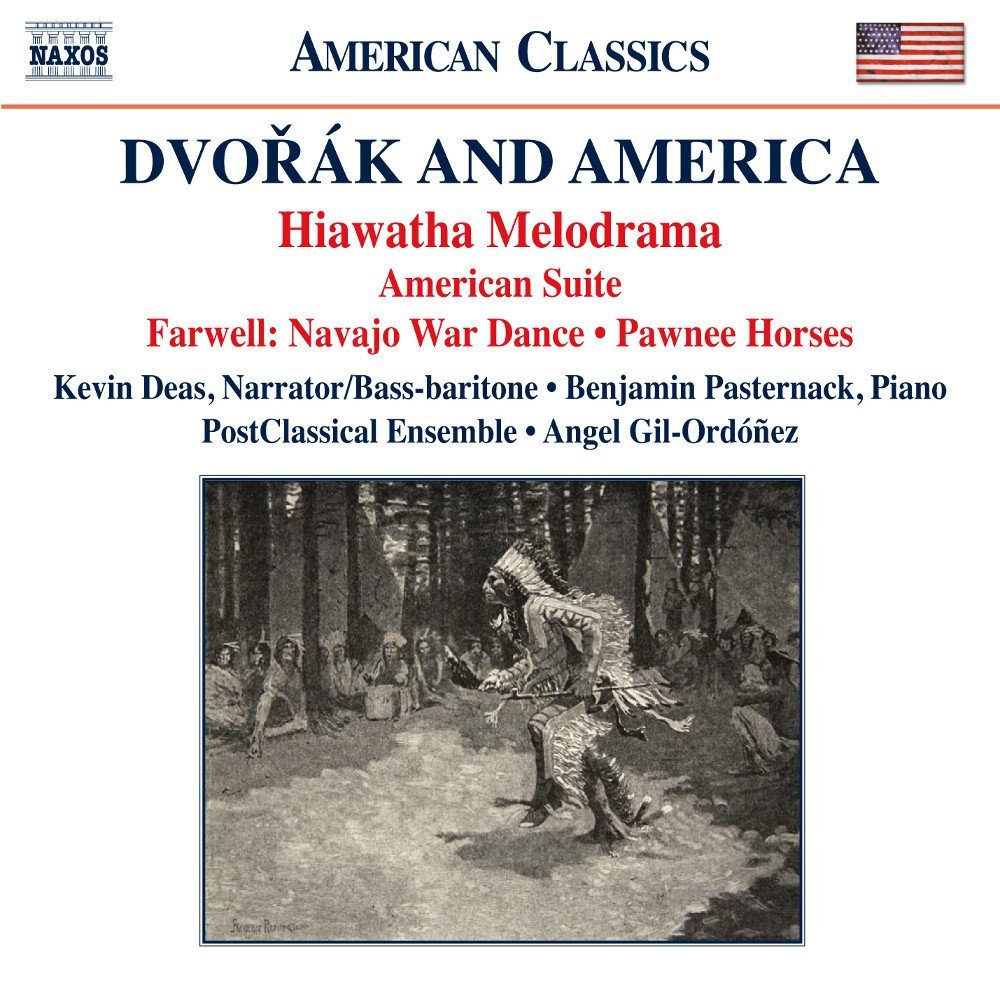Horowitz and Beckerman: Hiawatha Melodrama (after Dvořák)
Dvořák: American Suite/Violin Sonatina
Farwell: Navajo War Dance No. 2/Pawnee Horses
Kevin Deas, narrator/Benjamin Pasternak, piano/PostClassical Ensemble/Angel Gil-Ordóñez
Naxos 8.559777 (76:41)
It has long been known that Dvořák’s New World Symphony was inspired by African-American and Native American music. And Dvořák himself mentioned Longfellow’s The Song of Hiawatha as another source of inspiration. But most musicians and musicologists were reluctant to be more specific than that. In recent years, however, the musicologists Joseph Horowitz and Michael Beckerman have tried to show that all of these elements, especially the Hiawatha story, can be linked to specific passages in the New World Symphony.
Beckerman’s 2003 book New Worlds of Dvořák lays out all the evidence but Horowitz and Beckerman went even further in creating a Hiawatha Melodrama incorporating music from the symphony and other Dvořák pieces. I first heard a version of it in a Horowitz-curated Dvořák Festival at the University of Texas about ten years ago. I was not entirely convinced but I enjoyed the presentation immensely. This latest version on a new Naxos CD is even better than what I heard years ago and I am sure it will appeal to many music-lovers who love the symphony and thought they knew what it was all about.
Let’s be very clear about one thing. In spite of Horowitz and Beckerman’s research, Dvořák’s New World Symphony is not program music. In other words, it was not conceived as a story told in music as in Liszt’s or Richard Strauss’ symphonic poems, or even as in Dvořák’s own later tone poems such as The Noonday Witch or The Water Goblin. This is “absolute” music whose movements are easily analyzed as being in traditional forms (e.g. the sonata form first movement). But certain musical episodes can be related to passages in Longfellow’s poem and made to complement each other.
For me, however, the process breaks down when I see how arbitrarily the arrangers have chosen music to fit the words. They chop up the New World Symphony to suit the Hiawatha narrative and even bring in passages from other Dvořák works such as the Larghetto movement from the Sonatina for Violin and Piano. It seems to me that rather than making the case that Dvořák’s music was composed to express specific passages from the Song of Hiawatha, they do no more than show that some of Dvořák’s music works quite well as an accompaniment to parts of the Song of Hiawatha; and that is a very different thing. To put it another way, Horowitz and Beckerman are doing what most film directors do when they choose music to accompany words and images. And the fact is that music by other composers would work just as well as Dvořák’s New World Symphony as a “soundtrack” for Song of Hiawatha.
The Hiawatha Melodrama is narrated by Kevin Deas in a style that recalls the old-fashioned stage actors of the early Twentieth Century. It is a sing-song style which has long since gone out of fashion. I am reminded of Benjamin de Loache narrating Poe’s The Raven to music by Dubensky on a 1936 recording conducted by Stokowski. Otherwise the performances are all very good. But, of course, Song of Hiawatha is itself pretty dated.
Dvořák’s intent was to show American composers how they could use their own indigenous music to enrich their compositions and produce a genuinely American music. In general, not many composers learned much from Dvořák. But Arthur Farwell (1872-1952) was one who did and two of his pieces inspired by Native American music are included on this CD. The fact is, however, that while American composers were slow to find their voice, within twenty years or so of Dvořák’s death we had the fresh and original music of Ives, Copland, Gershwin and all that jazz.
This CD is available for purchase at Amazon.com.
- SCRUTINY | TSO Lets Berlioz Do The Talking In Season Opener - September 21, 2018
- RECORD KEEPING | Even Yannick Nézet-Séguin Can’t Make Us Love Mozart’s La Clemenza di Tito - September 6, 2018
- RECORD KEEPING | Giovanna d’Arco With Anna Netrebko Explains Why The Best Operas Survive - August 30, 2018




